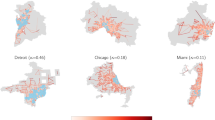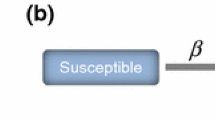Abstract
The implementation of intervention strategies plays a crucial role in preventing the spread of epidemics. In this study, we incorporated travel restrictions and detection measures into a metapopulation framework, creating an epidemic model that takes into account recurrent mobility patterns. We determined theoretical thresholds subject to two constraints and executed comprehensive simulations to validate the model, which is founded upon Markovian equations. Our empirical findings reveal that enhancing detection efficiency, implementing rigorous travel restrictions, and reducing the transmission rate among regulated groups can effectively curtail the ultimate spread of the epidemic. However, we observed that the influence of travel restrictions weakens as the network’s average degree increases. Additionally, reducing the restriction parameter does not yield a higher threshold compared to when the mobility rate is low, as seen from a threshold perspective.








Similar content being viewed by others
Data Availability
All the data used are generated by the algorithms described in the article, or their sources are shown in the references.
References
Cheng, Z.J., Zhan, Z., Xue, M., Zheng, P., Lyu, J., Ma, J., Zhang, X.D., Luo, W., Huang, H., Zhang, Y., et al.: Public health measures and the control of COVID-19 in China. Clin. Rev. Allergy Immunol. 1–16 (2021)
Kraemer, M.U., Yang, C.H., Gutierrez, B., Wu, C.H., Klein, B., Pigott, D.M., et al.: The effect of human mobility and control measures on the COVID-19 epidemic in China. Science 368(6490), 493–497 (2020)
Duan, W., Fan, Z., Zhang, P., Guo, G., Qiu, X.: Mathematical and computational approaches to epidemic modeling: a comprehensive review. Front. Comput. Sci. 9, 806–826 (2015)
Pastor-Satorras, R., Castellano, C., Van Mieghem, P., Vespignani, A.: Epidemic processes in complex networks. Rev. Mod. Phys. 87(3), 925 (2015)
Pastor-Satorras, R., Vespignani, A.: Epidemic spreading in scale-free networks. Phys. Rev. Lett. 86(14), 3200 (2001)
Chung, F., Lu, L., Vu, V.: The spectra of random graphs with given expected degrees. Internet Math. 1(3), 257–275 (2004)
Karrer, B., Newman, M.E.: Message passing approach for general epidemic models. Phys. Rev. E 82(1), 016101 (2010)
Mata, A.S., Ferreira, S.C.: Pair quenched mean-field theory for the susceptible-infected-susceptible model on complex networks. Europhys. Lett. 103(4), 48003 (2013)
Karrer, B., Newman, M.E., Zdeborová, L.: Percolation on sparse networks. Phys. Rev. Lett. 113(20), 208702 (2014)
Miller, J.C., Slim, A.C., Volz, E.M.: Edge-based compartmental modelling for infectious disease spread. J. R. Soc. Interface 9(70), 890–906 (2012)
Barbosa, H., Barthelemy, M., Ghoshal, G., James, C.R., Lenormand, M., Louail, T., Menezes, R., Ramasco, J.J., Simini, F., Tomasini, M.: Human mobility: models and applications. Phys. Rep. 734, 1–74 (2018)
Colizza, V., Vespignani, A.: Invasion threshold in heterogeneous metapopulation networks. Phys. Rev. Lett. 99(14), 148701 (2007)
Colizza, V., Pastor-Satorras, R., Vespignani, A.: Reaction-diffusion processes and metapopulation models in heterogeneous networks. Nat. Phys. 3(4), 276–282 (2007)
Soriano-Paños, D., Cota, W., Ferreira, S.C., Ghoshal, G., Arenas, A., Gómez-Gardeñes, J.: Modeling communicable diseases, human mobility, and epidemics: a review. Ann. Phys. 534(6), 2100482 (2022)
Soriano-Paños, D., Lotero, L., Arenas, A., Gómez-Gardeñes, J.: Spreading processes in multiplex metapopulations containing different mobility networks. Phys. Rev. X 8(3), 031039 (2018)
Han, D., Shao, Q., Li, D.: Exploring the epidemic spreading in a multilayer metapopulation network by considering individuals’ periodic travelling. Complexity 2020, 1–9 (2020)
Huang, J., Chen, C.: Metapopulation epidemic models with a universal mobility pattern on interconnected networks. Phys. A Stat. Mech. Appl. 591, 126692 (2022)
Liu, S.Y., Baronchelli, A., Perra, N.: Contagion dynamics in time-varying metapopulation networks. Phys. Rev. E 87(3), 032805 (2013)
Wang, B., Yang, L., Han, Y.: Intervention strategies for epidemic spreading on bipartite metapopulation networks. Phys. Rev. E 105(6), 064305 (2022)
Valgañón, P., Soriano-Paños, D., Arenas, A., Gómez-Gardeñes, J.: Contagion-diffusion processes with recurrent mobility patterns of distinguishable agents. Chaos Interdiscip. J. Nonlinear Sci. 32(4), 043102 (2022)
Gao, S., Dai, X., Wang, L., Perra, N., Wang, Z.: Epidemic spreading in metapopulation networks coupled with awareness propagation. IEEE Trans. Cybern. (2022)
Nie, Y., Zhong, X., Lin, T., Wang, W.: Pathogen diversity in meta-population networks. Chaos Solitons Fractals 166, 112909 (2023)
Shao, Q., Han, D.: Epidemic spreading in metapopulation networks with heterogeneous mobility rates. Appl. Math. Comput. 412, 126559 (2022)
Gong, Y.W., Song, Y.R., Jiang, G.P.: Epidemic spreading in metapopulation networks with heterogeneous infection rates. Phys. A Stat. Mech. Appl. 416, 208–218 (2014)
Soriano-Paños, D., Arias-Castro, J.H., Reyna-Lara, A., Martínez, H.J., Meloni, S., Gómez-Gardeñes, J.: Vector-borne epidemics driven by human mobility. Phys. Rev. Res. 2(1), 013312 (2020)
Wang, J., Han, D.: Epidemic spreading on metapopulation networks considering indirect contact. Phys. A Stat. Mech. Appl. 128722 (2023)
Zhu, X., Liu, Y., Wang, S., Wang, R., Chen, X., Wang, W.: Allocating resources for epidemic spreading on metapopulation networks. Appl. Math. Comput. 411, 126531 (2021)
Zhang, K., Han, Y., Gou, M., Wang, B.: Intervention of resource allocation strategies on spatial spread of epidemics. Phys. Rev. E 105(6), 064308 (2022)
Hurford, A., Rahman, P., Loredo-Osti, J.C.: Modelling the impact of travel restrictions on COVID-19 cases in Newfoundland and Labrador. R. Soc. Open Sci. 8(6), 202266 (2021)
Li, Y., Hou, S., Zhang, Y., Liu, J., Fan, H., Cao, C.: Effect of travel restrictions of Wuhan city against COVID-19: a modified SEIR model analysis. Disaster Med. Public Health Prep. 16(4), 1431–1437 (2022)
Russell, T.W., Wu, J.T., Clifford, S., Edmunds, W.J., Kucharski, A.J., Jit, M., et al.: Effect of internationally imported cases on internal spread of COVID-19: a mathematical modelling study. Lancet Public Health 6(1), e12–e20 (2021)
Chinazzi, M., Davis, J.T., Ajelli, M., Gioannini, C., Litvinova, M., Merler, S., Pastore y Piontti, A., Mu, K., Rossi, L., Sun, K., et al.: The effect of travel restrictions on the spread of the 2019 novel coronavirus (COVID-19) outbreak. Science 368(6489), 395–400 (2020)
Mugnaine, M., Gabrick, E.C., Protachevicz, P.R., Iarosz, K.C., de Souza, S.L., Almeida, A.C., Batista, A.M., Caldas, I.L., Szezech, J.D., Jr., Viana, R.L.: Control attenuation and temporary immunity in a cellular automata SEIR epidemic model. Chaos Solitons Fractals 155, 111784 (2022)
Hong, X., Han, Y., Wang, B.: Impacts of self-initiated behavioral responses and pandemic fatigue on the epidemic spread in time-varying multiplex networks. Chaos Solitons Fractals 173, 113696 (2023)
Hong, X., Han, Y., Wang, B.: Impacts of detection and contact tracing on the epidemic spread in time-varying networks. Appl. Math. Comput. 439, 127601 (2023)
Silva, D.H., Anteneodo, C., Ferreira, S.C.: Epidemic outbreaks with adaptive prevention on complex networks. Commun. Nonlinear Sci. Numer. Simul. 116, 106877 (2023)
Hong, X., Han, Y., Wang, B.: Integrated extensive detection, contact tracing and dynamical social distancing interventions to prevent future epidemic waves. IEEE Trans. Syst. Man Cybern. Syst. (2023)
Feng, S., Jin, Z.: Infectious diseases spreading on an adaptive metapopulation network. IEEE Access 8, 153425–153435 (2020)
Ni, S., Weng, W.: Impact of travel patterns on epidemic dynamics in heterogeneous spatial metapopulation networks. Phys. Rev. E 79(1), 016111 (2009)
Granell, C., Mucha, P.J.: Epidemic spreading in localized environments with recurrent mobility patterns. Phys. Rev. E 97(5), 052302 (2018)
Gómez-Gardeñes, J., Soriano-Panos, D., Arenas, A.: Critical regimes driven by recurrent mobility patterns of reaction-diffusion processes in networks. Nat. Phys. 14(4), 391–395 (2018)
Rossi, R.A., Ahmed, N.K.: The network data repository with interactive graph analytics and visualization. In: AAAI (2015). https://networkrepository.com
Funding
We acknowledge partial financial support by the National Natural Science Foundation of China (Grant No. 72243005), Youth Fund for Humanities and Social Sciences Research of the Ministry of Education (20YJC630059), Natural Science Foundation of Shanghai (21ZR1404700). In addition, we would like to thank the anonymous reviewers for their contributions.
Author information
Authors and Affiliations
Contributions
All authors contributed to the conceptualization, methodology, theoretical analysis, software and visualization. The first draft of the manuscript was written by Dun Han and Juquan Wang, and all authors commented on previous versions of the manuscript. All authors read and approved the final manuscript.
Corresponding author
Ethics declarations
Conflict of interest
The authors have no relevant financial or non-financial interests to disclose.
Additional information
Publisher's Note
Springer Nature remains neutral with regard to jurisdictional claims in published maps and institutional affiliations.
Rights and permissions
Springer Nature or its licensor (e.g. a society or other partner) holds exclusive rights to this article under a publishing agreement with the author(s) or other rightsholder(s); author self-archiving of the accepted manuscript version of this article is solely governed by the terms of such publishing agreement and applicable law.
About this article
Cite this article
Han, D., Wang, J. The effects of travel restrictions and detection measures on epidemic spreading in a metapopulation network. Nonlinear Dyn 111, 20511–20524 (2023). https://doi.org/10.1007/s11071-023-08902-z
Received:
Accepted:
Published:
Issue Date:
DOI: https://doi.org/10.1007/s11071-023-08902-z




